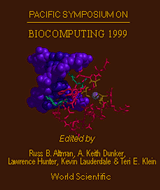Characterisation of side-chain conformational preferences in a biologically active but unfolded protein
Mathieson SI, Penkett CJ, Smith LJ
Oxford Centre for Molecular Sciences, University of Oxford, England.
Pac Symp Biocomput. 1999;:542-53.

Abstract
A combination of experimental NMR 3J alpha beta coupling constant measurements and theoretical predictions from a statistical model for a random coil have been used to characterise the conformations of amino acid side-chains in an unfolded fibronectin binding protein. The statistical model uses the distribution of torsion angles in a data base of native folded protein structures to provide a description of the torsion angle populations of each residue in a random coil. For all but three of the residues studied a close agreement is observed between the experimental 3J alpha beta data and the model predictions (correlation coefficient 0.90; RMSD 0.70 Hz). In these cases the populations about the chi 1 torsion angles in the conformational ensemble defining the fibronectin binding protein are well described by those present in the protein data base. For Phe 69, Asp 92 and Asp 105 however significant deviations are observed between the predictions and experimental data. Each of these side-chains is found to be involved in persistent non-random structural features arising from clustering of hydrophobic groups or interactions between charged side-chains. The analysis demonstrates the detailed insight that can be provided into conformationally disordered states by combining experimental and theoretical approaches.
[Full-Text PDF] [PSB Home Page]